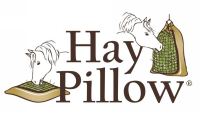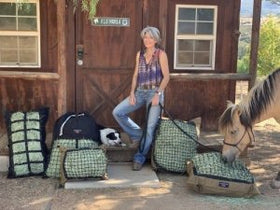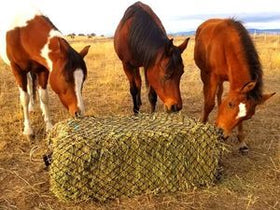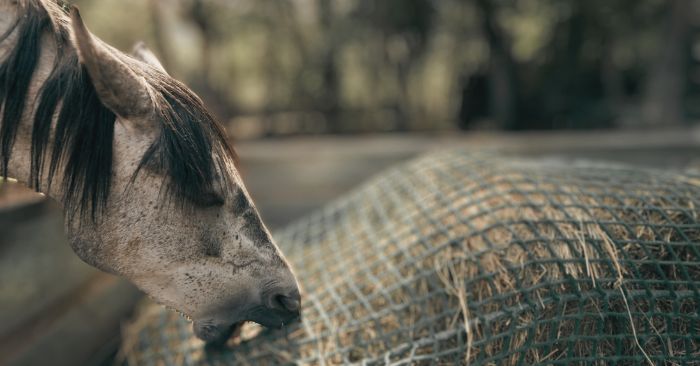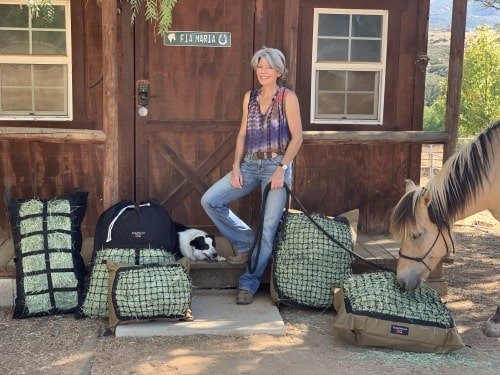Slow Feeding Fails: Avoid These Common Misconceptions
As a slow feed expert, I’ve helped thousands of customers over the last 12 years have happier, healthier horses, donkeys and mules. Many times, we work to alter and overcome common misconceptions I hear again and again.
Finding just the right regime for your equine can be a journey of experimentation and discovery, but the end result – the peace of mind you gain when it all works – is priceless.
The following misconceptions and solutions are those I address most frequently in conversations with well-meaning, loving equine guardians trying to do what’s best for their companions. I hope this information helps you avoid similar slow feeding challenges.

1. Frustration Is Okay
Misconception: My horse is frustrated with his hay net, but it’s okay, his dinner lasts twice as long.Truth: Frustration is a Red Flag. It:
- Increases gastric acid production
- Causes stress + induces ulcers
- Can result in damage to teeth, gums, and the slow feeder
- Defeats the purpose of slow-feeding
What to Do: Choose a larger mesh size. You can only slow him down as much as his patience level will allow for. Only when he can easily extract hay from and empty his feeder should you consider trying a smaller mesh size. If you do, always offer both the larger mesh size along with the smaller size to ease the transition. The key to a successful slow-feed program is to follow the core diet guidelines provided below and be vigilant about avoiding frustration. For more tips see our post, Slow Feeding - Transition Tips & Techniques

2. He'll Be Angry If I Change His Hay
Misconception: My horse, donkey, or mule loves his hay - it's soft and smells amazing - but he eats way too fast despite using a slow feeder. If I feed him hay he doesn't like as much to try to slow him down, he’ll be mad at me.
Truth: If he doesn’t have hay available 24/7, consider offering him both types. Feed very limited amounts of the hay that he loves twice a day to start. Along with that, offer a less palatable hay in a slow feeder (separately) for him to nibble on once he finishes the other. I assure you, he will not be mad at you if he has something to munch on for longer periods of time!
Why This Matters: Less palatable hay naturally slows consumption rate. Aroma and texture are the main contributing factors to palatability. Course mature hay with no discernible aroma is higher in indigestible fiber, lower in calories, and requires far more chew time per pound while drastically curbing his enthusiasm to eat it as quickly as possible. Soft aromatic hay is far more appealing, lower in indigestible fiber and higher in calories per pound. See our post, Can Horses Eat More Hay Without Weight Gain? The Surprising Factors

3. Slow Feeders Alone Will Manage My Equine's Weight
Misconception: Implementing slow feeders is the end-all-be-all solution to my equine’s weight management goals.Truth: When used correctly, slow feeding offers many benefits. It can assist in weight loss, help to regulate insulin spikes, keep equines occupied, reduce the risk of gastric ulcers and colic, enhance digestion, and improve metabolism - but it cannot compensate for:
- Hay that is high in calories, regardless of sugar/starch levels. See our post, Beyond Low Sugar/Starch - Choosing Hay for Weight Management
- Less than ideal levels of protein, vitamins, minerals, and omegas in the diet. No equine is immune to being malnourished, including overweight individuals.
- Periods of fasting exceeding 4-5 hours
- Crash diets. While it may seem counter intuitive, drastically reducing calories can quickly backfire - resulting in a sluggish metabolism, insulin spikes, muscle loss, and storage of fat to compensate.
What to Do: Follow these core diet guidelines to address weight:
- Forage: The absolute minimum amount of grass hay (less than 10% NSCs) to feed for weight loss or management is 1.5% of your horse's current body weight or 2% of ideal weight, whichever is more.
If you are not able to test your hay, see our post, A Safer Always Have Hay Source – Mature Grass Hay.
If you test your hay, see our post, Beyond Low Sugar/Starch - Choosing Hay for Weight Management.
Learn How & Where to Test Your Horse's Hay & Interpret Results. - Vitamins & Minerals: Provide a concentrated comprehensive vitamin/mineral grass hay balancer providing optimum levels of vitamins and minerals that are essential for proper thyroid/hormone function.
- Salt: Feed the minimum requirements in daily supplements and provide access to free choice loose salt or a white salt block.
- Omegas: Feed ground flaxseed at a rate of 4 ounces per 1,000 pounds of body weight. One ounce of ground flaxseed is approximately 1/4 cup. Omega 3s are especially fragile and quickly destroyed during the curing process of grass hay.

More often than not, by choosing the most appropriate forage and following these core diet guidelines, you can confidently feed more than 1.5 - 2% of body weight to provide adequate bulk, satiation, and chew time while achieving favorable results.
To learn more about what a healthy diet should include and how periods of fasting worsen Insulin Resistance/Dysregulation, see our post Healthy Gradual Weight Loss for Horses vs. Fasting & Forage Restriction.

4. All Day on Pasture + Severe Hay Restriction at Night
Misconception: I need a slow feed hay bag with a super small mesh size to feed my horse at night. She is turned out on pasture from 8:00 am – 6:00 pm and fed 3 pounds of hay in a stall at night. She eats all of it in an hour. I need a slow feeder to make 3 lbs. of hay last all night.
Truth: Slow feeders alone cannot counteract the adverse effects of this scenario. Equines turned out on pasture during the day without a grazing muzzle, when sugar levels are highest, and brought into a stall or dry lot overnight with a meager meal of hay are primed for high circulating insulin levels. Both high sugar and starch intake and fasting for more than a few hours promote or worsen Insulin Resistance and Dysregulation.
What to Do: Ideally, to support lower insulin levels, forage intake should be low in sugar and starch, allocated as equally as possible over a 24-hour period. This can be accomplished by using a grazing muzzle during pasture time. If possible, change the pasture turn out from late night to morning when sugars are likely to be lowest. See our post, Sugar Content of Pasture & Hay: Q & A with Katy Watts, Founder of Safergrass.org
During the day (or night), in their dry lot or stall, feed a minimum of .75 - 1 % of body weight - split into two feedings or free-choice - of appropriate grass hay via slow feeders following the core diet guidelines provided above.

5. Slow Feeders for Boarded Equines
Misconception: I board my horse. He finishes his breakfast, lunch, and dinner in a couple of hours. I am most concerned about overnight. He has nothing to eat after 8:00 pm until breakfast is fed at 7:00 am. I need a slow feeder to make 5 pounds of hay last 11 hours.
Truth: Achieving a rate of consumption of less than 1 pound per hour, without frustration, for a meal-fed equine is not realistic.
What to Do: Follow the core diet guidelines provided above and allocate the amount of hay fed over a 24-hour period (breakfast 25%, lunch 25%, dinner 50%). Request the barn feed smaller amounts of their hay (with possibly a credit) at meal times and provide your own, very mature, grass hay in a slow-feeder to fill in the gaps between meals. Although you will be spending $75-$125 more a month for hay, the peace of mind is priceless. See our post, A Safer Always Have Hay Source – Mature Grass Hay.

Consider using multiple slow feeders for your mature grass hay. You can fill them ahead of time to make it easier for barn staff if they are not willing to refill them. It is a wise investment and you won’t spend any more. A device that is used 25% of the time will last four times longer!
Alternatively, large or small bale nets are a very economical slow-fed free-choice feeder and do not have to be filled as frequently. See our Mounting & Hanging Tips to view a variety of ways to use these and/or small mesh hay nets.
When You Find the Right Solution - It's Golden
These are some of the happy customer, happy horse success stories that keep me passionate about my mission.
"My horse, Ranger, just loves his Hay Pillow feeders. My vet wanted me to decrease his intake of hay and the hay pillow seemed to be the best option because it gave him free access to all the hay he wanted and slowed his intake. I did not feel like I was starving him. I started with a bag with a 1 3/4" opening for about four months. Then I purchased a bag with a 1 1/4" opening which I gave him along with the 1 3/4" bag. Something amazing happened -- he chose to eat even less hay! He eats from both bags, but never empties either. I think he feels more secure because he has so much hay available to him. When I started using two hay pillows, I also saw a pattern of indentations on his face and discovered that he was sleeping with his hay pillow!! Ranger loves his hay and his pillow; and my vet is pleased with his weight loss. I'm so glad this product exists. Thanks HayPillow! " ~ Karen
"My horse is in a stall from 3:00 pm to 9:00 am the next morning. I have struggled to keep him occupied and make his forage last. I have tried hanging bags, but our barn manager hates having to fill them with hay. I purchased The Hay Pillow because it’s on the ground and easy to fill. It has exceeded my expectations. My horse loves it. You can see in the picture - he has a choice of eating the loose hay on the ground or eating the hay in The Hay Pillow. And the surprising thing is he prefers The Hay Pillow! Everyone is happy!" ~ Susan
"Hay Pillow has saved my horse during his rehabilitation. Kahn sustained a severe injury to his neck and shoulder, and is currently on strict stall rest. My horse who used to be in moderate work and spend 12 hours a day in turn out, is now enclosed in a medium sized corral, and not even allowed hand walking. He became extremely bored, and developed habits such as pacing, pawing, and damaging his pen. He also was very aggressive at feeding time and would devour his hay in less than 30 minutes.
I didn't want to use a slow feeding hay net, as I feared a hanging net would aggravate his neck injury and frustrate him. I am so thankful to have discovered hay pillow. I followed the directions closely on how to introduce it, and he loves it. He genuinely seems to enjoy the process of extracting hay, and each feeding now lasts hours instead of minutes. He is happier, no longer displaying bored and destructive behaviors, and is much calmer at feeding time." ~ Candace
"Hello and thanks so much for all you do to help horses and those who love them. I got my first pair of horses in Dec 2018. Naturally, I got a LOT of advice— mostly conflicting in nature. My guys were an overweight Clydesdale, Cactus Jack, and his friend, a quarter horse we named Einstein. We were cautioned by the previous owner that Cactus was an aggressive eater and his excess weight was increasing health risks. Three months later we adopted a severely underweight Arabian horse. I tried over feeding to help mitigate the food aggression (as recommended by one vet). This backfired. Another vet suggested separate feeding and minimizing food intake by Cactus Jack. This also yielded terrible results and anxiety in ALL horses.
I came across the Haypillow website and called. The lady who answered was so kind and patient. She listened to my concerns, asked me questions about our ranch and set up. Ultimately I went with three hay pillows as some free feed in separate bins. It’s been four months, and my Clydesdale (shown here) has actually LOST weight! They always have food and so are not stressed. Their moods and disposition has improved. We actually have harmony in what several horse owners and trainers had told me was an impossible situation." ~ Darlene
"Two horses. Four medical challenges. One outstanding slow feeding solution that addresses all four! We are dealing with Insulin Resistance, Asthma, Chronic Gutteral Pouch Infection, and Uveitis. All four conditions benefit from a head down, open air, slow feeding method that keeps them moving. Thank you, Hay Pillow, for checking off all four boxes! I am 100% a believer in your product and use multiple pillows scattered around for each feeding." ~ Julie
In Review
Finding just the right regimen to keep your beloved equines happy and healthy can be stressful and challenging - but worth the effort! I hope this simplifies things by providing practical solutions for a successful slow feed program.
Listen to Our Interview on Horsemanship Radio
Debbie Loucks of Horsemanship Radio interviews Monique Warren on slow feeding horses. Listen in at the 32 minute marker on Horsemanship Radio - Episode 260.
Helpful Resources
- Horse Slow Feeder Safety Tips
- 9 Benefits of Slow Feeding - Get Slow Feed Savvy
- Beyond Low Sugar/Starch - Choosing Hay for Weight Management
- Slow Feed Solutions by Enclosure Type and Weather Condition
- Healthy Gradual Weight Loss for Horses vs. Fasting & Forage Restriction
- 7 Easy Ways to Help Prevent Equine Colic
- How & Where to Test Your Horse's Hay & Interpret Results
- Are You a Prisoner of Feeding? Here's How I Broke Free
- Equine Gut Health - The Need for Feed
References
- Kellon, E (2022, September 19) Minerals and Insulin Resistance. Retrieved from https://drkhorsesense.wordpress.com/2022/09/19/minerals-and-insulin-resistance/
- Bertin, F., Taylor, S., Bianco, A., Sojka‐Kritchevsky, J. (2016, Aug 2) The Effect of Fasting Duration on Baseline Blood Glucose Concentration, Blood Insulin Concentration, Glucose/Insulin Ratio, Oral Sugar Test, and Insulin Response Test Results in Horses. Retrieved from https://www.ncbi.nlm.nih.gov/pmc/articles/PMC5032872/
- Kellon, E (2020, November 27) Topping Off Hay Diets. Retrieved from https://drkhorsesense.wordpress.com/2020/11/27/topping-off-hay-diets/
- Getty, J. Quality of Life for the Overweight, Insulin-Resistant Horse. Retrieved from https://gettyequinenutrition.com/pages/quality-of-life-for-the-overweight-insulin-resistant-horse
- Kellon, E. Nutritional Needs for Equine Metabolic Syndrome (EMS) and PPID/Cushing's Horses. Retrieved from https://www.ecirhorse.org/DDT+E-diet.php
- Kellon, E. (2021, May 24). Flax To Mimic Pasture. Retrieved from https://drkhorsesense.wordpress.com/2021/05/24/flax-to-mimic-pasture/
